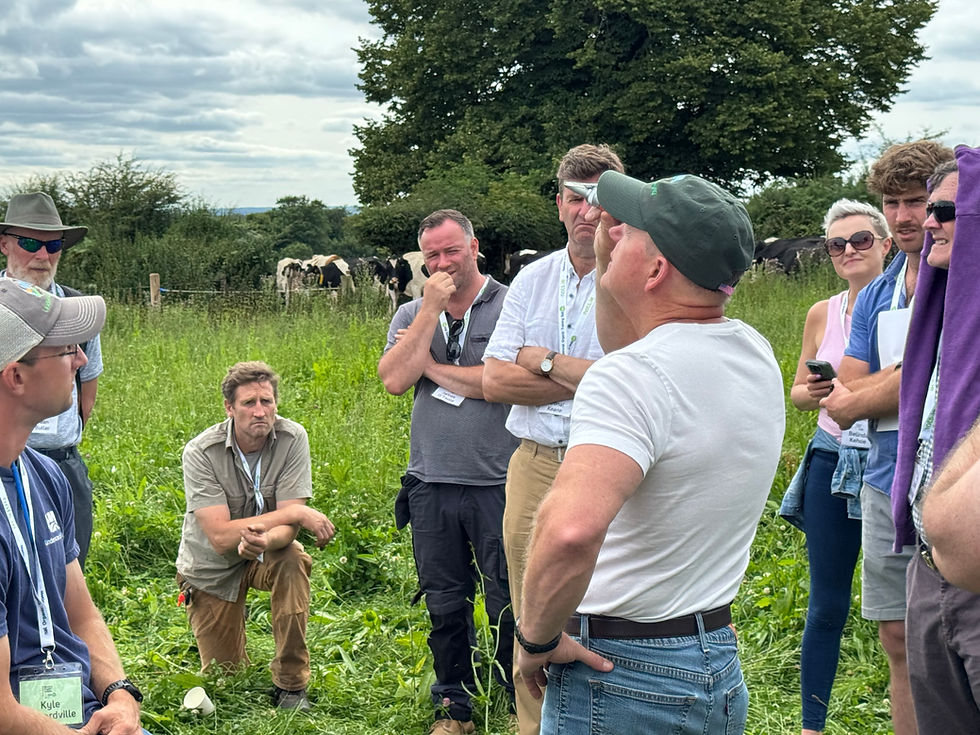Brix - Why It Matters
- Christopher Williams

- Aug 1, 2024
- 3 min read
In the realm of agriculture, both crop production and livestock grazing hinge on the health and quality of plants. A critical measure of this quality is Brix, a term that might not be familiar to everyone but holds significant importance for farmers and agriculturalists. In this blog, we’ll delve into what Brix is, how it is measured, its benefits, and why it plays a crucial role in regenerative agriculture and livestock management.
What is Brix?
Brix is a scale used to measure the sugar content in an aqueous solution, named after Adolf Brix, the German scientist who developed it. One degree Brix (°Bx) corresponds to 1 gram of sucrose in 100 grams of solution, representing the percentage of sugar by weight in the liquid. While it primarily measures sugars like sucrose, glucose, and fructose, it also accounts for other dissolved solids such as vitamins, minerals, amino acids, proteins, and hormones.
Measuring Brix


To measure Brix, a refractometer is typically used. This instrument calculates the refractive index of a liquid sample, which changes based on the concentration of dissolved solids.
Here’s a step-by-step guide on how to measure Brix in plants:
Collect a Sample:
Select a representative plant sample, ideally from the top third where sugar concentration is highest.
For consistent results, collect samples at the same time of day, as Brix levels fluctuate due to photosynthesis.
Extract the Sap:
Crush or squeeze the plant sample to release the sap.
Place a few drops of the sap on the refractometer’s lens.
Read the Brix Value:
Look through the refractometer’s eyepiece to see the Brix scale and record the value. You can measure the value by where the two colors meet.
Interpreting Results:
Low Brix (1-6): Indicates poor forage quality with low sugar and nutrient content.
Medium Brix (7-12): Reflects average forage quality with moderate sugar content.
High Brix (13+): Signifies excellent forage quality with high sugar and nutrient levels.
The Benefits of High Brix Levels
High Brix levels are indicative of several beneficial factors in both crop production and livestock grazing:
Enhanced Plant Health:
Plants with higher Brix levels are typically healthier, with stronger immune systems that are more resistant to pests and diseases.
High Brix levels correlate with greater nutrient density, resulting in more nutritious crops.
Improved Flavor and Quality:
Increased sugar content enhances the taste, texture, and overall quality of fruits and vegetables.
Crops with high Brix readings tend to have a longer shelf life and more vibrant colors.
Better Livestock Nutrition:
Forage with high Brix levels provides more readily available energy, improving livestock health, weight gain, and milk production.
Livestock grazing on high Brix forage have better feed efficiency and overall performance.
Economic Benefits:
Healthier crops and livestock reduce the need for chemical inputs and veterinary interventions, lowering production costs.
High-quality produce and livestock products can command higher market prices.
Brix and the Energy Cycle
Brix levels are closely linked to the energy cycle in plants, which involves capturing sunlight and converting it into chemical energy through photosynthesis:
Photosynthesis Efficiency: High Brix levels indicate efficient photosynthesis, where plants effectively convert sunlight into sugars. These sugars are stored energy used for growth and development.
Soil Microbial Activity: Sugars exuded by plant roots feed soil microbes, enhancing soil biology and nutrient cycling. Healthy microbial communities improve soil structure and fertility.
Plant Resilience: Plants with high Brix levels have more stored energy, making them more resilient to environmental stressors like drought and pests.
Practical Applications in Agriculture
Crop Production:
Soil Management: High Brix readings are often a sign of healthy soil. Implementing regenerative practices like cover cropping, minimal tillage, and livestock integration can improve soil health and increase Brix levels.
Crop Monitoring: Regular Brix measurements allow farmers to monitor plant health and adjust irrigation, fertilization, and pest control practices accordingly.
Livestock Grazing:
Pasture Management: Measuring Brix in forage helps farmers assess its nutritional quality and make informed decisions about grazing intensity, rest periods, and rotation schedules.
Adaptive Grazing and Brix
Adaptive grazing, which involves implementing variable grazing strategies based on current conditions and goals, can help maintain high Brix levels in forage. Farmers using this technique monitor Brix levels to assess the impact of their grazing strategies and make adjustments to optimize forage quality and livestock health. Due to the nature of photosynthesis and brix, it is optimal for maximum gain, to graze in the afternoon during the highest levels of photosynthesis.
Summary
Brix is a valuable tool in both crop production and livestock grazing, providing insights into the nutritional quality of plants. By regularly measuring and interpreting Brix levels, farmers can make informed decisions that enhance plant health, improve livestock performance, and promote regenerative agricultural practices. High Brix levels not only benefit the plants and animals but also support overall ecosystem health and farm profitability.
Incorporating Brix measurements into your agricultural practices can lead to a more resilient and productive farming system, ultimately contributing to the regeneration and success of your operation.





Comments